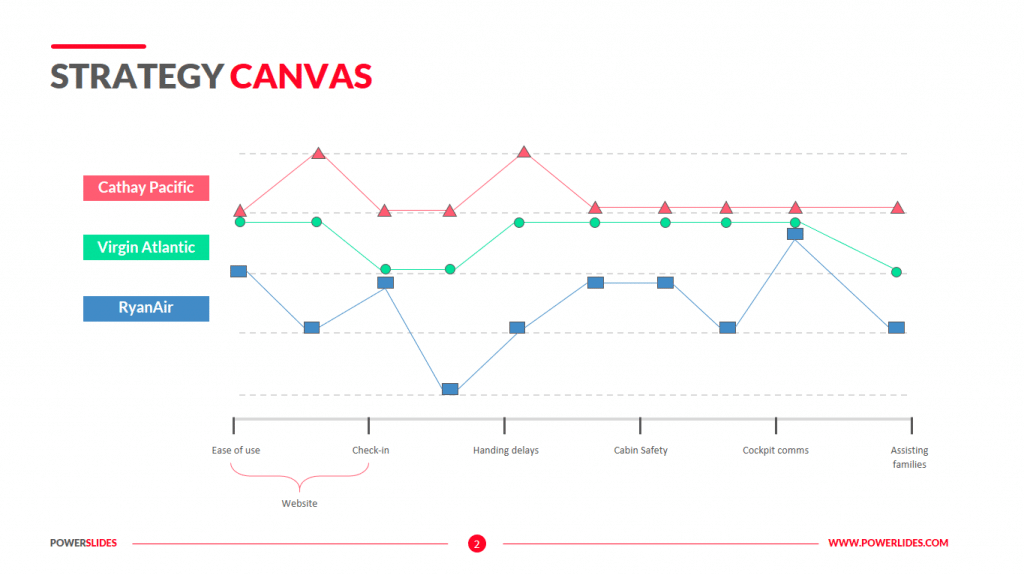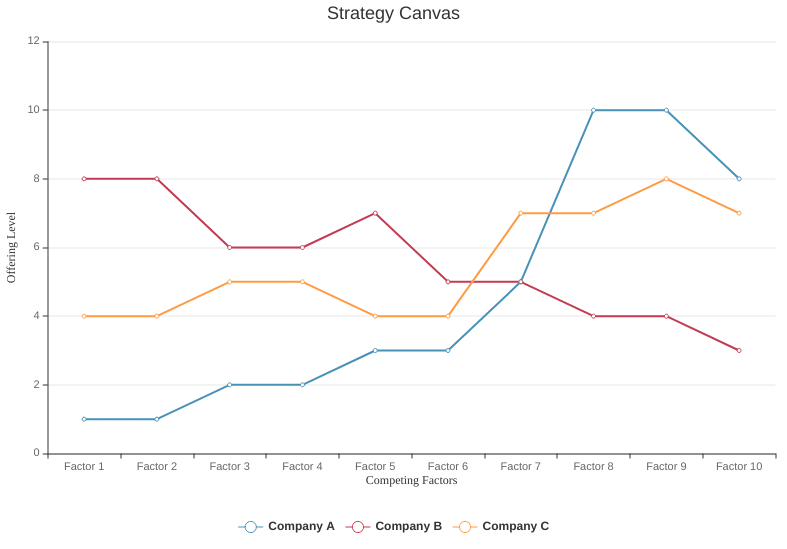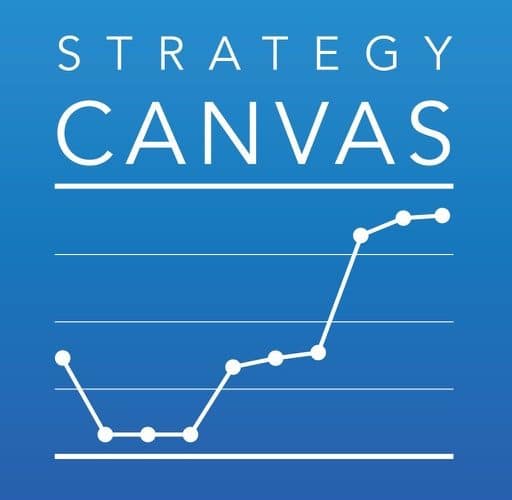The strategy canvas is a vital aspect of competitive strategy. A strategy canvas allows your organization to see in one picture all the factors an industry competes and invests in. This article will be discussing the strategy canvas blue ocean, template. We will also use an example to further elaborate on the usefulness of the the canvas strategy.

Strategy Canvas
A strategy canvas is a line graph that plots functions/factors against the value of a company and then overlays industry benchmarks. However, by doing this, information can be built to help create a competitive strategy. It is a central diagnostic tool that graphically shows the current strategic landscape and the future prospects for an organization.
However, the horizontal axis on the strategy canvas shows the factors that the industry competes in and invests in. While the vertical axis shows the contribution level that buyers receive across all of these key competing factors.
Additionally, a strategy canvas allows your organization to see in one picture all the factors an industry competes and invests in. Also, it shows what buyers receive, and what the strategic profiles of the major players are. It reveals how similar the players’ strategies look to buyers. Also, it shows how they drive the industry toward the red ocean. Importantly, it formulates a generally owned baseline for change.
There are two basic purposes of the strategy canvas:
- It shows the current state of play in the known market space. Hence, allowing users to clearly see the factors that industry competes on and invests in. Also, as what buyers receive, and what the strategic profiles of the major players are.
- Secondly, it drives users to action by reshaping their focus from competitors to alternatives. Also, from customers to noncustomers of the industry. Then enables you to see how a blue ocean strategic move breaks away from the existing red ocean reality.
How to Make a Strategy Canvas
There are several ways how to make a strategy canvas, however, here are some steps you must go through.
#1. Identify the competition
The first step to making a Strategy Canvas is to know who your competition is. In fact, this is vital to any strategic thinking process. However, depending on the nature of your industry, you could identify individual competitors by name, particularly the top brands. Also, you might find it easier to gather them into a smaller number of semi-homogeneous groups. Nevertheless, never forget to include your own business, whether you are in the market yet or not.
When identifying competitors, it is always crucial to look at the problem from the customer’s perspective. Ask yourself, who or what else could satisfy my customer needs?
#2. Identify the various factors of competition
You need to identify the factors that your customers value when deciding on the product or service you are offering. However, these include the price, meals, lounges, seating choices, etc.
The easiest way to do this is to actually get out and speak to your target customers. However, there are several research methods you could use. Remember, it is relevant to speak to people who have already bought your product and service. Also, people who buy it but from your competitor, and people who don’t yet buy your product but might in the future. However, people don’t always know what they want, so you may need to get creative in order to find out.
#3. Evaluate the competition
The third step is to draw the actual chart. Draw a line for each competitor showing their performance in terms of each of the factors that customers value.
It is often preferable to do steps 1 to 3 with a team in a closed room. There, you see how different people’s strategy maps look in terms of the competitors they select. And also the factors they view as important, and how they rate the competition.
#4. Chart your competitive differentiation
Now you are ready to map your new strategy Canvas. The objective is to chart a line that is much different from the lines of any of your competitors. That difference, that unusual blend of competitive factors, is your competitive differentiation.
Moreover, not just any differentiation will do. You must pick a combination that an ample number of your target customers will find compelling. Hence, sustaining your commercial objectives.
What Is the 4 Actions Framework?
A strategy canvas is a line graph that compares the relative importance of various functions or variables for a business or organization, with those of its rivals or industry standards superimposed on top. In this way, data can be amassed for use in crafting an edge over the competition.
What Are the Five Key Areas of Strategy?
Arenas, points of difference, automobiles, staging, and logic of capitalism are the five pillars of strategy. Donald Hambrick and James Fredrickson, researchers in the field of strategy, created this model.
Strategy Canvas Blue Ocean
The Strategy Canvas Blue Ocean is a model with which you can compare products or companies. However, it is one of the most famous models from Blue Ocean Strategy, the famous strategy book from 2005.
With the Strategy Canvas, you can perform an analysis, but it is also an action framework. Having done the strategy canvas, it is obvious what the similarities and differences between your company and the competition are. You can also immediately see what you should improve.
On the horizontal axis, you place the most relevant parameters for the specific product or company that you want to analyze. However, on the vertical, you show whether this value is high or low at the company you are reviewing.
Now, let’s see some the strategy canvas example.
Strategy Canvas Example
Here we compare 2 Iphones. Another superb example we will look at is fast food and restaurant. Here we can compare Kentucky Fried Chicken KFC and Domino Pizza.
You can think of these parameters for example during brainstorming. You can safely choose 7 to 10 parameters. However, make sure you only add parameters that really matter, if not, you get an unclear image. The disadvantage of the Blue Ocean Strategy Canvas is that no value is given to the parameter.
What Is Strategy Canvas Template?
The strategy canvas is a useful visual aid that summarizes a company’s product or service offering in a single page and shows how it compares to the competition. For developing a successful “blue ocean” strategy, it can be used both as a diagnostic instrument and as a guide for taking decisive action.
Strategy Canvas Template
Here is a template for a strategy canvas. However, this strategy canvas template is depleted in the image below.

Key Uses Of The Strategy Canvas
According to Chan Kim and Renée Mauborgne authors of the blue ocean strategy, the goal of comparing solutions is to uncover variables on which incumbents compete. Secondly, to come up with new ideas for goods with a different value proposition, this way, you are better positioned to compete in the market with an advantage.
Tips on building a Strategy Canvas
The following five tips will definitely help you draw a compelling strategy canvas.
#1. You must define the scope of your Strategy Canvas
Before using the strategy canvas, make sure you identify the scope of adopting this strategy. This talks about your purpose of use and the result you hope to achieve. Generally, it can be used to compare solutions inside a specific sector or market, as well as solutions that target specific client segments.
#2. Determine the factors on which incumbents compete
You know, each product in a competitive market is known for something. These are the edge they each have against the other. So it is vain to begin a comparison without first identifying what your factors are. Determine the factors on which incumbents compete. You can start by finding five to ten factors on which existing solutions or incumbents compete. But in all your variables, make sure you include quality, price, value, and other key factors that consumers hold in high esteem.
#3. Rank the incumbents’ factors you identified
Having identified the factors that competitors compete against, especially the ones you’d like to use as your parameters, you will proceed to rank these in other of importance. To do this, it is advisable to assign a numeric value to each factor. Using the measurement should be represented by a number, and each number should indicate a value.
#4. Draw Canvas
The next tip is to draw your canvas with the factors you ranked. In drawing your canvas, ensure the price factor is at the left. Kim and Mauborgne suggested this, apparently, everything to the right reflects the value clients receive for the price they spend.
#5. Compare your current or planned products and services to incumbents
The last thing you’ll do is to compare your product against your competitors on the graph. This will help you identify their key distinction and with that, it will be easier to come up with better options.
Conclusion
In conclusion, a strategy canvas allows your organization to see in one picture all the factors an industry competes and invests in. Also, it shows what buyers receive, and what the strategic profiles of the major players are. Hope the example and template above help you understand the strategy canvas, how it works, and its importance in businesses? Indeed Chan Kim and Renée Mauborgne did present a vital tool to businesses.
Strategy Canvas FAQs
What is the aim of a strategy canvas?
A strategy canvas is a line graph that plots functions/factors against the value of a company and then overlays industry benchmarks. However, by doing this, information can be built to help create a competitive strategy.
How do you create a strategy canvas?
There are several ways how to make a strategy canvas, however, here are some steps you must go through.
- #1. Identify the competition
- #2. Identify the factors of competition
- #3. Evaluate the competition
- #4. Chart your competitive differentiation
- How to gain a competitive advantage
- Photography Business Cards: Free Templates, Samples, Ideas, Tools (+ Quick Guide)
- Business Strategy: Levels of Business Strategy+10 Best Business Strategy Examples
- First mover strategy – How to benefit [Case study]
- Salon Business Cards: Catchy templates and Ideas to inspire you (+ quick tools)






